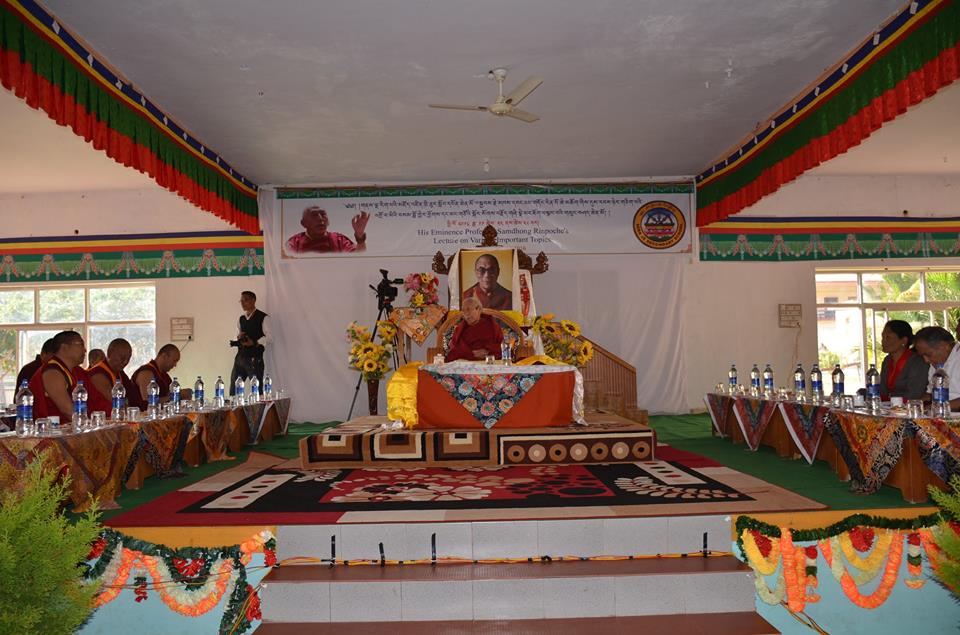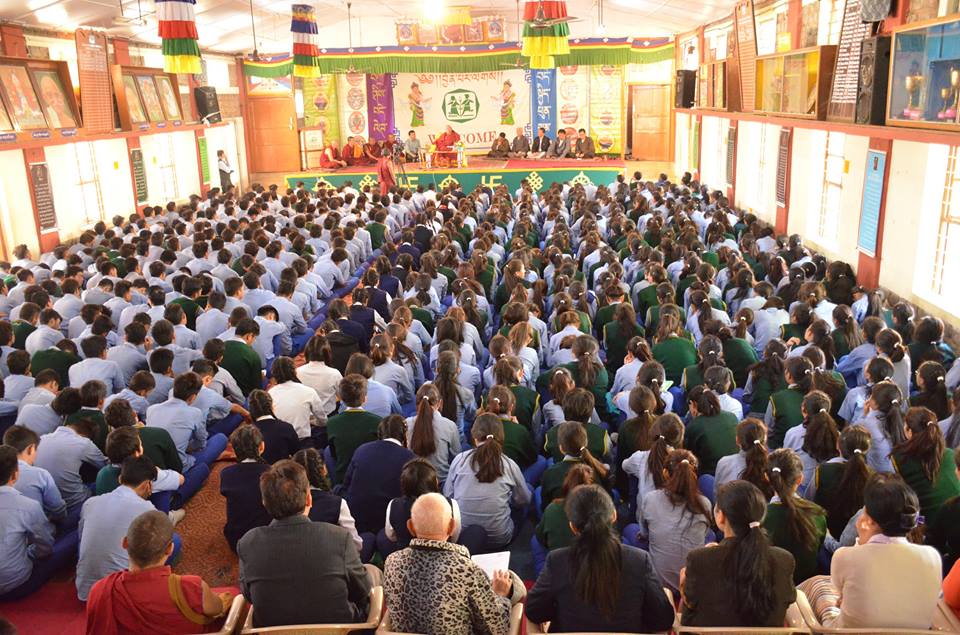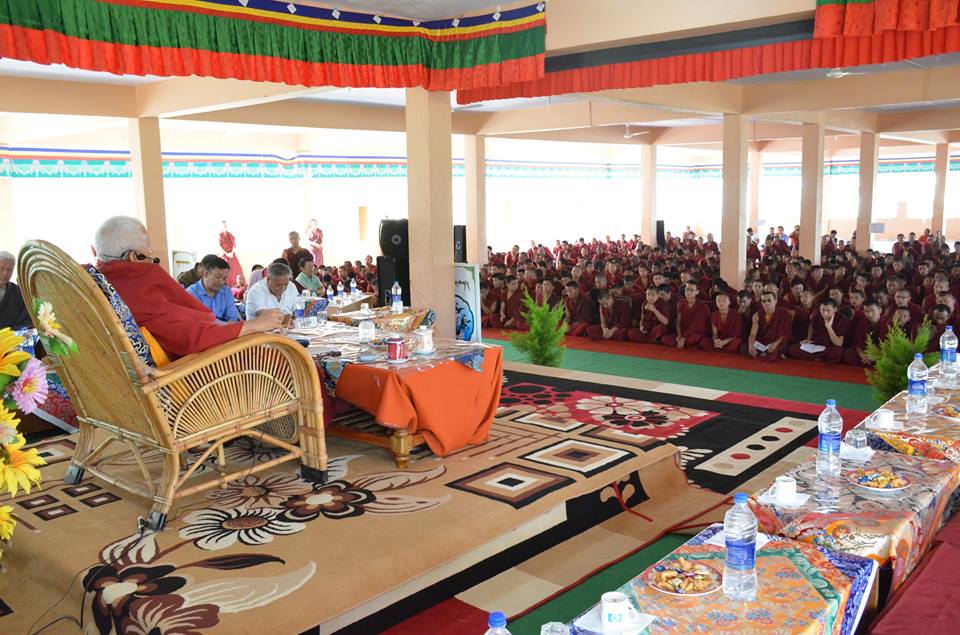His Eminence Prof. Samdhong Rinpoche’s guidance in southern India
After addressing, as the Chief Guest, the concluding session of the national conference “Colloquium of ‘Nation First’ Thinkers and Practitioners,” in Bhopal, His Eminence Prof. Samdhong Rinpoche travelled to the southern Indian city of Chennai, where, for three days (18 November 2016 – 20 November 2016), His Eminence Rinpoche, along with Ven. Tenzin Priyadarshi, conducted a Retreat, organised by Maitrim Poshas Trust, in a hall of Madras School of Economics, and had intensive Dialogue on “Self-Realisation;” “Why we are not changing?;” and “Individual Responsibility.”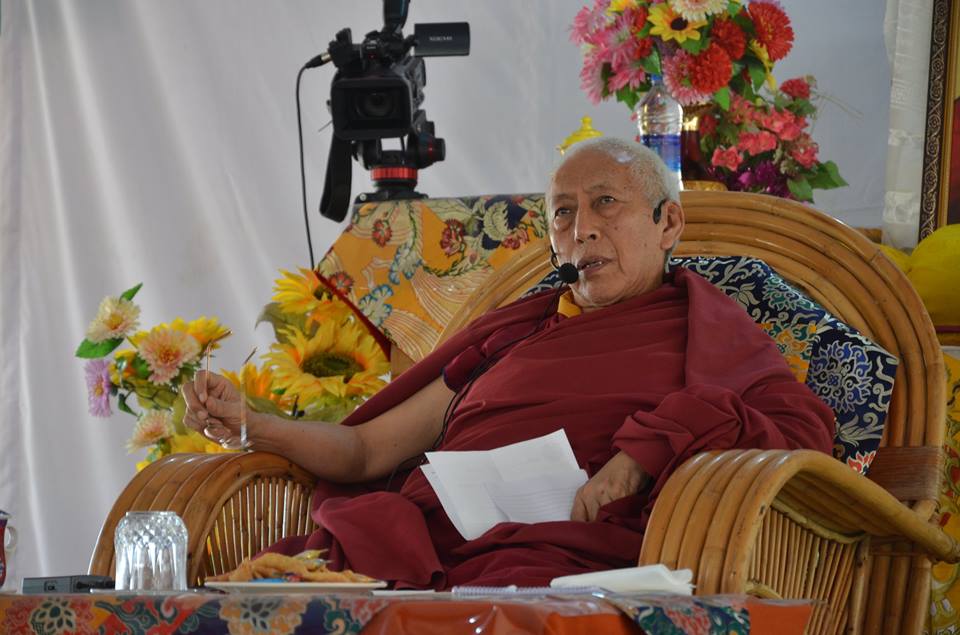
There also took place a panel discussion on “Uncompromising ethics for a compromised world,” with His Eminence Prof. Samdhong Rinpoche, Ven. Tenzin Priyadarshi and Shri Gurumurthy.
On 21 November 2016 His Eminence Prof. Samdhong Rinpoche headed to Rishi Valley, Andhra Pradesh, and on the morning of 22 November 2016 gave a talk on “Living Responsibility in today’s world,” at Krishnamurti Foundation India, Gathering 2016. There followed Q/A at the end of the talk; around 300 followers of Krishnamurti attended the talk.
From Rishi Valley, His Eminence Rinpoche travelled to Sera Je Secondary School, Bylakuppe, near Mysore city, for a 4-days guidance lecture series at the monastic school.
On the morning of 25 November 2016, at the start of the lecture, in the hall of Sera Je Secondary School, Ven. Tenzin Jangchup, Director, Sera Je Secondary School, gave an introduction on the needs and objectives of making the request for the 4-days guidance lecture series.
His Eminence Prof. Samdhong Rinpoche began the guidance lecture on the theme of “Tradition and Modernity: their nature, differences, functions, benefits and harms, etc.” His Eminence Rinpoche pointed out at the start the relevance—although not directly, yet indirectly—of the topics to the monastics.
Thereafter His Eminence Rinpoche explained the etymological understanding of the word “Modernity,” and explained: how Modernity had come about as a challenge against Totalitarianism, and through political struggle;even though it began with dependence on politics and society, Modernity has at the end turned out to do with Economy; how its influence pervades all branches of sustaining the society.
His Eminence Rinpoche explained the characteristics of Modernity, and the inequality it has brought as regards body and mind, the individual and the collective, self and ot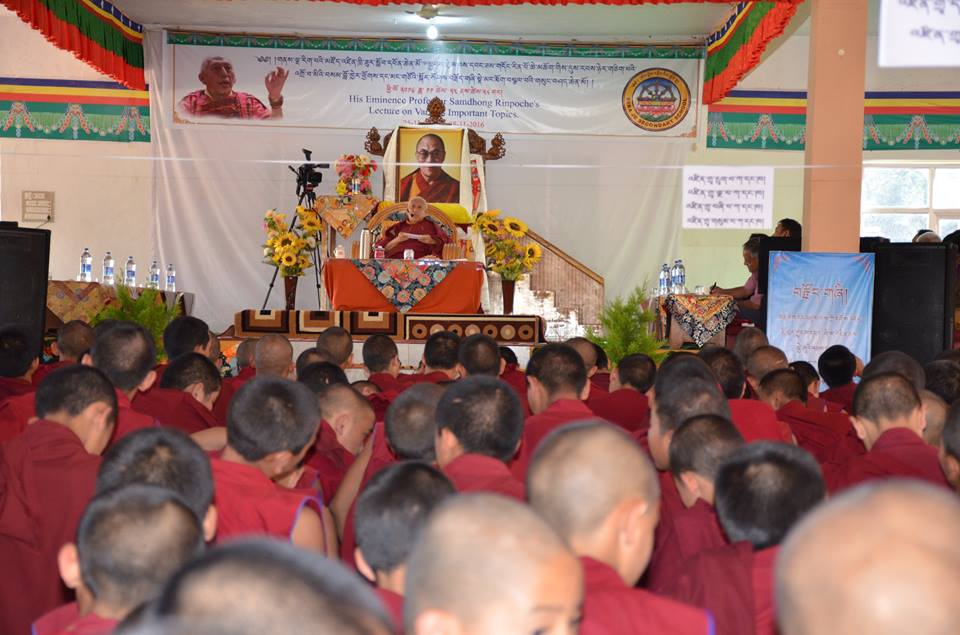 hers, competition and cooperation, rights and responsibilities; and how Modernity has caused environmental degradation and violence.
hers, competition and cooperation, rights and responsibilities; and how Modernity has caused environmental degradation and violence.
His Eminence Prof. Samdhong Rinpoche explained the characteristics of Tradition, and how it is different from mere custom. His Eminence Rinpoche touched upon these and many further insights in details, and answered questions at the end.
In the afternoon of 26 November 2016His Eminence Prof. Samdhong Rinpoche gave a guidance lecture on the theme of “Globalization: background, objectives, the merits and demerits to the entire world.” His Eminence Rinpoche observed that globalization is a direct result of Modernity, how Modernity emerged simultaneously with Industrialisation, how globalization has come about to be able to sell products also in other places; the channels through which globalization is practised are International Monetary Fund (IMF), The World Bank, World Trade Organization (WTO), and the multinational companies.
On the objectives of globalization His Eminence Prof. Samdhong Rinpoche pointed out how through financial influence there is the aim to gain power and control globally, and through that, to face no obstacles in business transactions, export and import. On the demerits or the adverse consequences of globalization, His Eminence Rinpoche said that the gravest losses suffered under globalization are by the small traders and local businesses.
In the afternoon of 27 November 2016 His Eminence Prof. Samdhong Rinpoche gave a guidance lecture on the theme of “How the need and want for science and technology came about, and the benefits and harms, directly and indirectly, they have brought to humanity.”
His Eminence Rinpoche explained the understanding of what are meant by “science” and “technology,” and remarked that there are two diverse opinions as regards the nature of these two: those who assert that they are neutral by nature, rather it is dependent on the user; and the other view which asserts that science and technology are harmful or unwholesome by nature—His Eminence presented the background thinking and rational of the two.
His Eminence Prof. Samdhong Rinpoche explained in detail Gandhi’s views on Science and technology. Rinpoche answered in detail the questions at the end.
In the morning of 28 November 2016, at the request of Tibetan Children’s Village School (TCV), Bylakuppe, His Eminence Prof. Samdhong Rinpoche gave a talk on the theme of “The importance of ethics in relation with modern education,” at the school. His Eminence Rinpoche advised that a good education would instil naturally a good ethics, and that along with the attribute of learnedness, there should be as well the other two attributes: of practising—implementing into practice—and of kindness, scripturally termed “nobility.”
Other guidance advice His Eminence gave were: Ethics is not something to be poured in from outside, nor to be taught on the side, rather it has to be together from within education; if the nature of education is not identified it is difficult for ethics to come about; if education is able to awaken one’s intellect, all conducts would become ethical through that power; the present education system of gathering information has no relation with improvement of the mind; knowledge of many things, through the present education, has no bearing on helping a person’s mental continuum; if ethics is taught as a separate subject, are other subjects unrelated with ethics?
His Eminence continued: If one realises the presentation of the view of dependent-arising, non-violence comes about naturally; to be ethical is to be totally non-violent—directly, indirectly, or otherwise; to help or to benefit others is a distinct ethics; ethics and education cannot be separated; it is important to identify the wrong view in the modern education system that education can be given through fear and greed; ethics would not come about naturally in an environment of education system of comparison and competition; a valid education is to come from the combination of the four: teacher, student, parents and the society.
In emphasising the need of wholesome participation of all four, His Eminence explained in detail that since teachers are as the medium for ethics, they need to be very careful in their ethical conducts, because their physical manners, vocal expressions and mental attitudes naturally rub off to the students; when the standards of the teachers, parents and the society go higher, the students’ standards go higher. Thereafter His Eminence Rinpoche outlined in detail the immense endeavour being put by His Holiness the Dalai Lama in promoting throughout the world universal responsibility and secular ethics.
In the afternoon of 27 November 2016 His Eminence Prof. Samdhong Rinpoche gave the last of the 4-day guidance lecture series at Sera Je Secondary School. On the requested theme of “Merits and demerits of Partyless democracy, in particular in the context of the Tibetan society,” His Eminence Rinpoche pointed out how the present-day political parties lack adherence to their basic principles; how they prioritise their party interests over national interests; how national unity is adversely affected by political parties; how they lead to corruption.
Besides giving insights in detail into the background thoughts for a partyless democracy His Eminence Rinpoche explained how a partyless system would be right for the Tibetan society, in terms of its numerous sectional components.
His Eminence Rinpoche answered questions at the end, and thereafter the Director of Sera Je Secondary School gave a gratitude speech. The guidance lecture series were attended by a large audience comprising of Members of Parliament (Central Tibetan Administration), the Directors and Principals of the local schools, the teachers and students of Sera Je Secondary School, the monastic scholars of Sera Je, teachers and students from other local schools.

